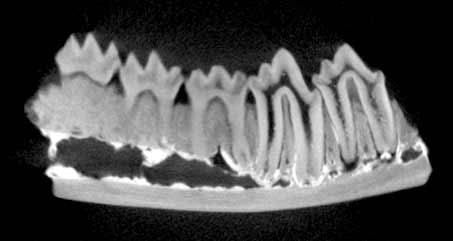Arundelconodon hottoni is remarkable because it is the first early Cretaceous mammal discovered on the eastern seaboard of the United States, and is one of the most complete triconodontid specimens from North America.
During the Mesozoic, over a period of nearly 100 million years, the history of Mammalia was played out exclusively by very small species. These animals were the size of today's mice and shrews, the very largest no bigger than a domestic cat. They are rare in the fossil record because their tiny, fragile bones require exceptional circumstances for preservation. Even when preserved, they present miniscule objects that are exceedingly difficult to find. Vast exposures of arid badlands in the Western Interior have provided our best record of Mesozoic mammalian history in North America, but the evidence is rare and fragmentary. Even less is known of what was happening on the East Coast during the Mesozic, because there is only a small area of outcrop of suitable rocks, and because most of those outcrops are heavily vegetated.
Arundelconodon is a member of Triconodontidae, an extinct lineage that lies very near the base of the mammalian family tree. In North America, most triconodontids are known only from isolated teeth. The most complete close relative known from North America, represented by a partial skull and skeleton, is Gobiconodon, from the Early Cretaceous of Montana. The most complete specimen discovered to date is the recently described type specimen of Jeholodens jenkinsi, from the Liaoning region of China. This specimen is virtually complete, although crushed. From all of these specimens, the anatomy and geographical distribution of triconodontids are becoming well-known, and new insights into the origin and early evolution of mammals are emerging.
The internal structure of this specimen of Arundelconodon is of particular interest in that it shows a feature shared by members of Triconodontidae from the Cretaceous of North America, which evidently represent an evolutionary radiation endemic to the continent. In Arundelconodon, ridges and grooves run the entire lengths of the root surfaces on adjacent molars. It is thought that these helped lock the molars together, so that they could act as a single functional unit. Triconodontids have well developed cutting surfaces on their molars. Though generally of small body size, it is likely that they incorporated vertebrate prey into their diet and thus represent an early assay into mammalian carnivory.

About the Species
This specimen, a right lower jaw, is the holotype. It was collected from the Lower Cretaceous Arundel Clay facies of the Potomac Group (Aptian), near Muirkirk, Prince Georges County, Maryland. The specimen was brought to the University of Texas High-Resolution X-ray CT Facility for scanning by Dr. Richard Cifelli of the University of Oklahoma. Scanning was funded by of The University of Texas at Austin.

About this Specimen
The specimen was scanned by Richard Ketcham on 13 November 1998 perpendicular to its long axis for a total of 32 slices, each slice 0.115 mm thick, with an interslice spacing of 0.097 mm (for a slice overlap of 0.018 mm). The dataset displayed was reduced for optimal Web delivery from the original, higher-resolution CT data.
 |
A sample slice through the jaw from the original dataset illustrates the detail discernible in the unreduced CT data. |

About the
Scan
Literature
Cifelli, R. L., T. R. Lipka, C. R. Schaff, and T. B. Rowe. 1999. First early Cretaceous mammal from the eastern seaboard of the United States. Journal of Vertebrate Paleontology 19:199-203.
Jenkins, F. A. Jr., and C. R. Schaff. 1988. The early Cretaceous mammal Gobiconodon (Mammalia, Triconodonta) from the Cloverly Formation of Montana. Journal of Vertebrate Paleontology 8:1-24.
Ji, Q., Z. Luo, and S-a. Ji. 1999. A Chinese triconodont mammal and mosaic evolution of the mammalian skeleton. Nature 398:326-330.
Luo, Z. 1994. Sister-group relationships of mammals and transformations of diagnostic mammalian characters; pp. 98-128 in N. C. Fraser, and H.-D. Sues (eds.), In the Shadow of the Dinosaurs: Early Mesozoic Tetrapods. Cambridge University Press, Cambridge.
Rowe, T. 1993. Phylogenetic systematics and the early history of mammals; pp. 129-145 in F. S. Szalay, M. J. Novacek, and M. C. McKenna (eds.), Mammalian Phylogeny. Springer-Verlag, New York.
Rowe, T. 1999. At the roots of the mammalian tree. Nature 398:283-284.

Literature
& Links
None available.

Additional
Imagery

